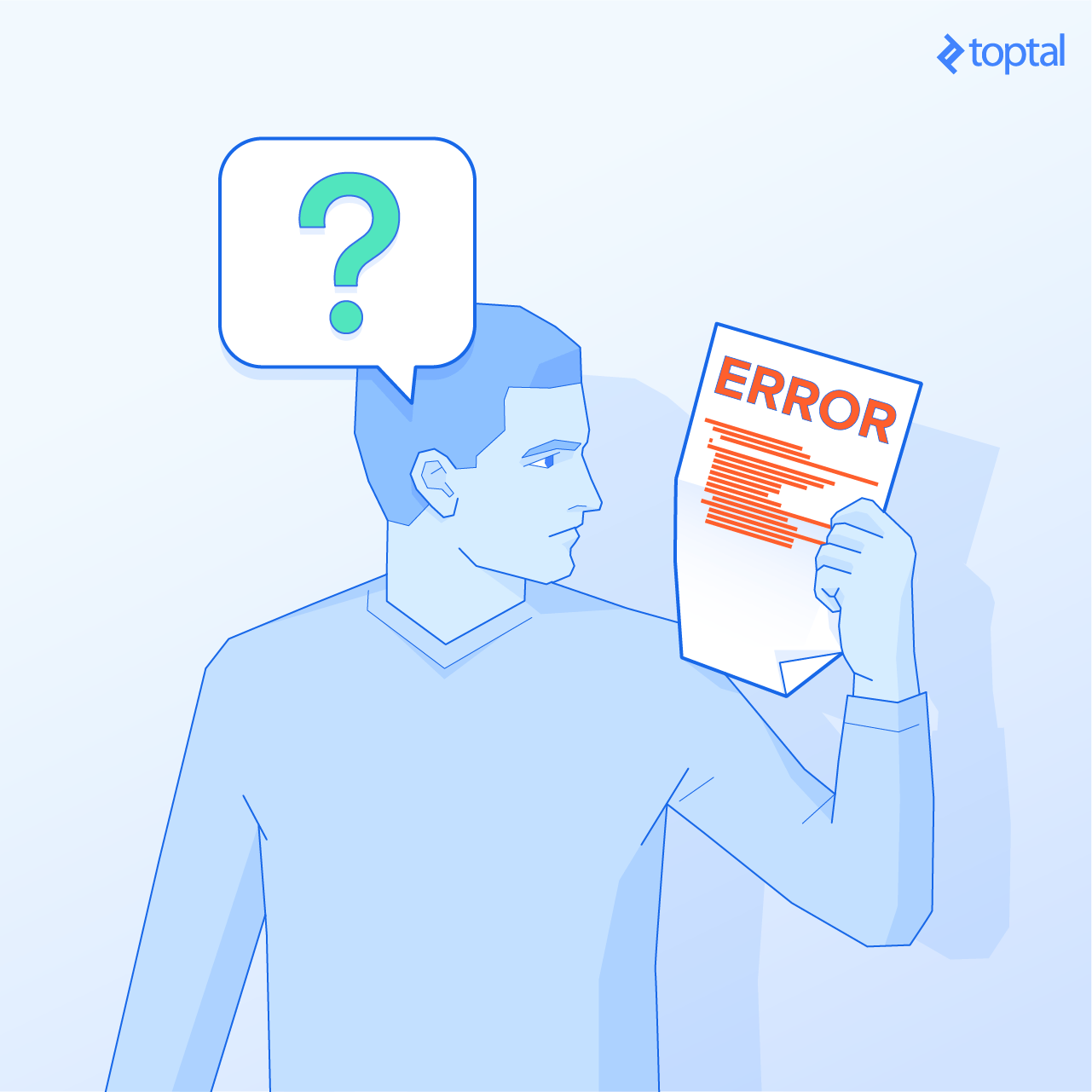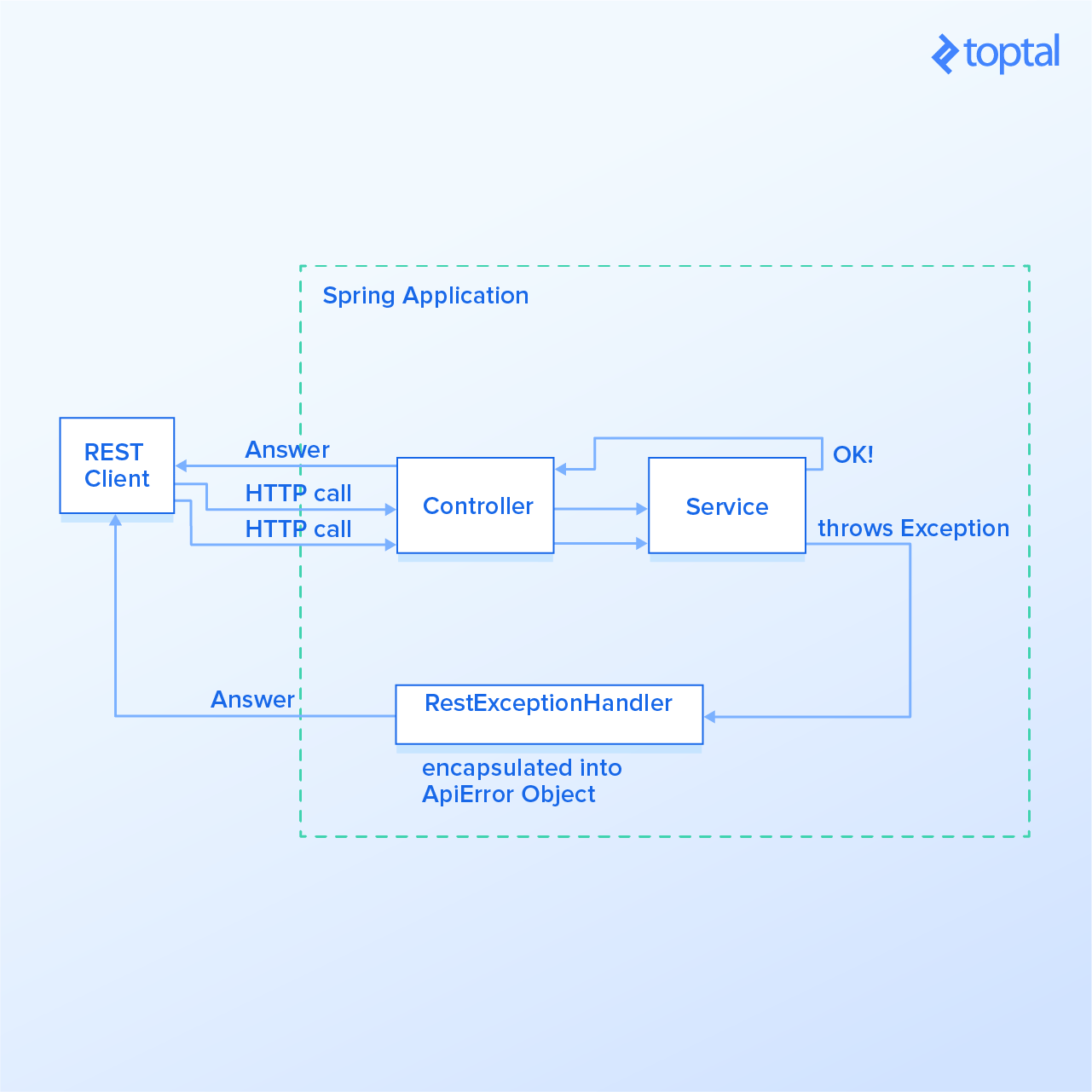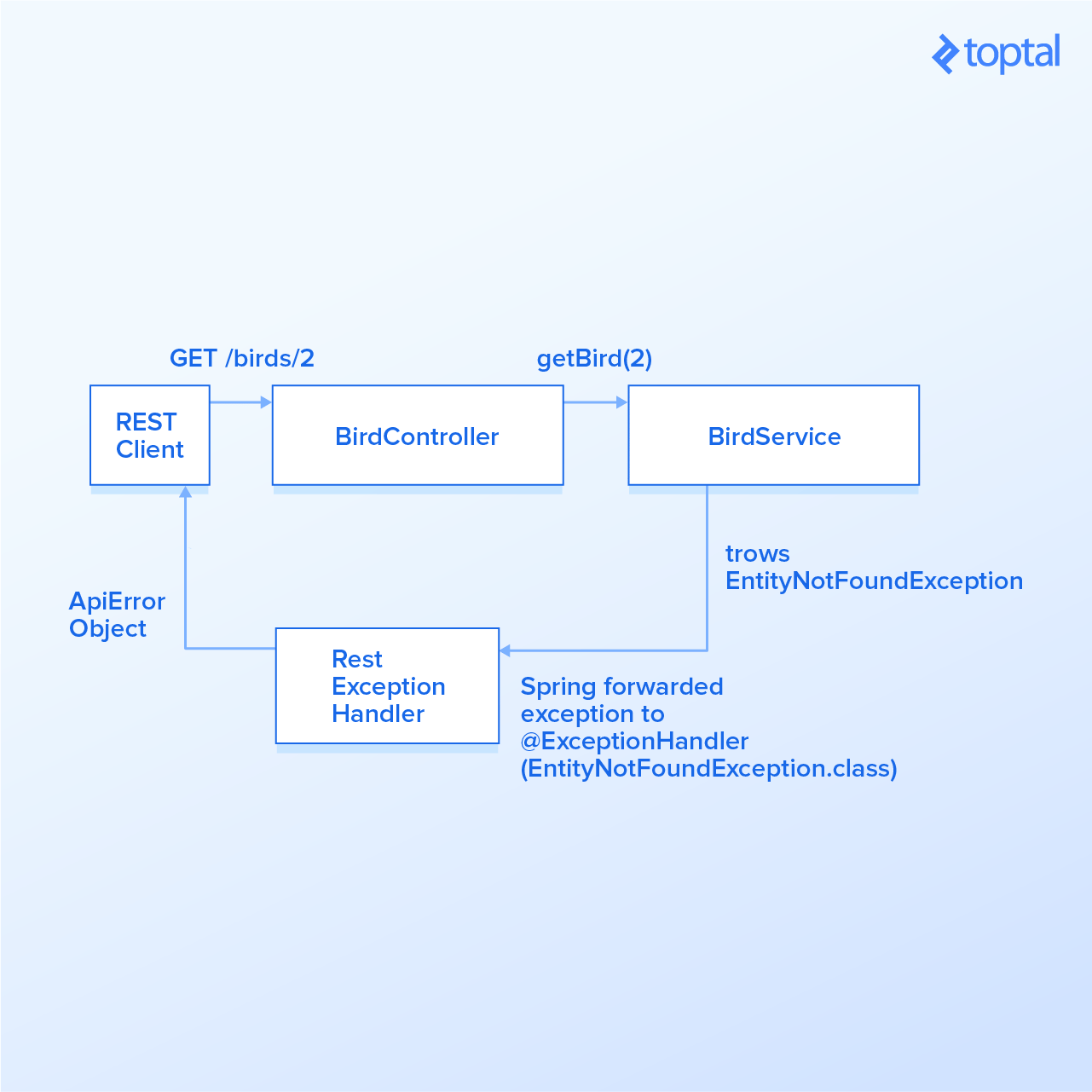Guide to Spring Boot REST API Error Handling
Spring Boot provides beneficial error messages to engineers building REST APIs. Yet, those messages are useless for the general API consumer. We provide a simple approach to improving this functionality.
Spring Boot provides beneficial error messages to engineers building REST APIs. Yet, those messages are useless for the general API consumer. We provide a simple approach to improving this functionality.
Bruno is a full-stack application architect and developer with more than 10 years of experience and a solid problem-solving track record.
PREVIOUSLY AT

Editor’s note: This article was updated on September 5, 2022, by our editorial team. It has been modified to include recent sources and to align with our current editorial standards.
The ability to handle errors correctly in APIs while providing meaningful error messages is a desirable feature, as it can help the API client respond to issues. The default behavior returns stack traces that are hard to understand and ultimately useless for the API client. Partitioning the error information into fields enables the API client to parse it and provide better error messages to the user. In this article, we cover how to implement proper Spring Boot exception handling when building a REST API .

Building REST APIs with Spring became the standard approach for Java developers. Using Spring Boot helps substantially, as it removes a lot of boilerplate code and enables auto-configuration of various components. We assume that you’re familiar with the basics of API development with those technologies. If you are unsure about how to develop a basic REST API, you should start with this article about Spring MVC or this article about building a Spring REST Service.
Making Error Responses Clearer
We’ll use the source code hosted on GitHub as an example application that implements a REST API for retrieving objects that represent birds. It has the features described in this article and a few more examples of error handling scenarios. Here’s a summary of endpoints implemented in that application:
GET /birds/{birdId} | Gets information about a bird and throws an exception if not found. |
GET /birds/noexception/{birdId} | This call also gets information about a bird, except it doesn't throw an exception when a bird doesn't exist with that ID. |
POST /birds | Creates a bird. |
The Spring framework MVC module has excellent features for error handling. But it is left to the developer to use those features to treat the exceptions and return meaningful responses to the API client.
Let’s look at an example of the default Spring Boot answer when we issue an HTTP POST to the /birds endpoint with the following JSON object that has the string “aaa” on the field “mass,” which should be expecting an integer:
{
"scientificName": "Common blackbird",
"specie": "Turdus merula",
"mass": "aaa",
"length": 4
}
The Spring Boot default answer, without proper error handling, looks like this:
{
"timestamp": 1658551020,
"status": 400,
"error": "Bad Request",
"exception": "org.springframework.http.converter.HttpMessageNotReadableException",
"message": "JSON parse error: Unrecognized token 'three': was expecting ('true', 'false' or 'null'); nested exception is com.fasterxml.jackson.core.JsonParseException: Unrecognized token 'aaa': was expecting ('true', 'false' or 'null')\n at [Source: java.io.PushbackInputStream@cba7ebc; line: 4, column: 17]",
"path": "/birds"
}
The Spring Boot DefaultErrorAttributes-generated response has some good fields, but it is too focused on the exception. The timestamp field is an integer that doesn’t carry information about its measurement unit. The exception field is only valuable to Java developers, and the message leaves the API consumer lost in implementation details that are irrelevant to them. What if there were more details we could extract from the exception? Let’s learn how to handle exceptions in Spring Boot properly and wrap them into a better JSON representation to make life easier for our API clients.
As we’ll be using Java date and time classes, we first need to add a Maven dependency for the Jackson JSR310 converters. They convert Java date and time classes to JSON representation using the @JsonFormat annotation:
<dependency>
<groupId>com.fasterxml.jackson.datatype</groupId>
<artifactId>jackson-datatype-jsr310</artifactId>
</dependency>
Next, let’s define a class for representing API errors. We’ll create a class called ApiError with enough fields to hold relevant information about errors during REST calls:
class ApiError {
private HttpStatus status;
@JsonFormat(shape = JsonFormat.Shape.STRING, pattern = "dd-MM-yyyy hh:mm:ss")
private LocalDateTime timestamp;
private String message;
private String debugMessage;
private List<ApiSubError> subErrors;
private ApiError() {
timestamp = LocalDateTime.now();
}
ApiError(HttpStatus status) {
this();
this.status = status;
}
ApiError(HttpStatus status, Throwable ex) {
this();
this.status = status;
this.message = "Unexpected error";
this.debugMessage = ex.getLocalizedMessage();
}
ApiError(HttpStatus status, String message, Throwable ex) {
this();
this.status = status;
this.message = message;
this.debugMessage = ex.getLocalizedMessage();
}
}
-
The
statusproperty holds the operation call status, which will be anything from 4xx to signal client errors or 5xx to signal server errors. A typical scenario is an HTTP code 400: BAD_REQUEST when the client, for example, sends an improperly formatted field, like an invalid email address. -
The
timestampproperty holds the date-time instance when the error happened. -
The
messageproperty holds a user-friendly message about the error. -
The
debugMessageproperty holds a system message describing the error in detail. -
The
subErrorsproperty holds an array of suberrors when there are multiple errors in a single call. An example would be numerous validation errors in which multiple fields have failed. TheApiSubErrorclass encapsulates this information:
abstract class ApiSubError {
}
@Data
@EqualsAndHashCode(callSuper = false)
@AllArgsConstructor
class ApiValidationError extends ApiSubError {
private String object;
private String field;
private Object rejectedValue;
private String message;
ApiValidationError(String object, String message) {
this.object = object;
this.message = message;
}
}
The ApiValidationError is a class that extends ApiSubError and expresses validation problems encountered during the REST call.
Below, you’ll see examples of JSON responses generated after implementing these improvements.
Here is a JSON example returned for a missing entity while calling endpoint GET /birds/2:
{
"apierror": {
"status": "NOT_FOUND",
"timestamp": "22-07-2022 06:20:19",
"message": "Bird was not found for parameters {id=2}"
}
}
Here is another example of JSON returned when issuing a POST /birds call with an invalid value for the bird’s mass:
{
"apierror": {
"status": "BAD_REQUEST",
"timestamp": "22-07-2022 06:49:25",
"message": "Validation errors",
"subErrors": [
{
"object": "bird",
"field": "mass",
"rejectedValue": 999999,
"message": "must be less or equal to 104000"
}
]
}
}
Spring Boot Error Handler
Let’s explore some Spring annotations used to handle exceptions.
RestController is the base annotation for classes that handle REST operations.
ExceptionHandler is a Spring annotation that provides a mechanism to treat exceptions thrown during execution of handlers (controller operations). This annotation, if used on methods of controller classes, will serve as the entry point for handling exceptions thrown within this controller only.
Altogether, the most common implementation is to use @ExceptionHandler on methods of @ControllerAdvice classes so that the Spring Boot exception handling will be applied globally or to a subset of controllers.
ControllerAdvice is an annotation in Spring and, as the name suggests, is “advice” for multiple controllers. It enables the application of a single ExceptionHandler to multiple controllers. With this annotation, we can define how to treat such an exception in a single place, and the system will call this handler for thrown exceptions on classes covered by this ControllerAdvice.
The subset of controllers affected can be defined by using the following selectors on @ControllerAdvice: annotations(), basePackageClasses(), and basePackages(). ControllerAdvice is applied globally to all controllers if no selectors are provided
By using @ExceptionHandler and @ControllerAdvice, we’ll be able to define a central point for treating exceptions and wrapping them in an ApiError object with better organization than is possible with the default Spring Boot error-handling mechanism.
Handling Exceptions

Next, we’ll create the class that will handle the exceptions. For simplicity, we call it RestExceptionHandler, which must extend from Spring Boot’s ResponseEntityExceptionHandler. We’ll be extending ResponseEntityExceptionHandler, as it already provides some basic handling of Spring MVC exceptions. We’ll add handlers for new exceptions while improving the existing ones.
Overriding Exceptions Handled in ResponseEntityExceptionHandler
If you take a look at the source code of ResponseEntityExceptionHandler, you’ll see a lot of methods called handle******(), like handleHttpMessageNotReadable() or handleHttpMessageNotWritable(). Let’s see how can we extend handleHttpMessageNotReadable() to handle HttpMessageNotReadableException exceptions. We just have to override the method handleHttpMessageNotReadable() in our RestExceptionHandler class:
@Order(Ordered.HIGHEST_PRECEDENCE)
@ControllerAdvice
public class RestExceptionHandler extends ResponseEntityExceptionHandler {
@Override
protected ResponseEntity<Object> handleHttpMessageNotReadable(HttpMessageNotReadableException ex, HttpHeaders headers, HttpStatus status, WebRequest request) {
String error = "Malformed JSON request";
return buildResponseEntity(new ApiError(HttpStatus.BAD_REQUEST, error, ex));
}
private ResponseEntity<Object> buildResponseEntity(ApiError apiError) {
return new ResponseEntity<>(apiError, apiError.getStatus());
}
//other exception handlers below
}
We have declared that in case of a thrownHttpMessageNotReadableException, the error message will be “Malformed JSON request” and the error will be encapsulated in the ApiError object. Below, we can see the answer of a REST call with this new method overridden:
{
"apierror": {
"status": "BAD_REQUEST",
"timestamp": "22-07-2022 03:53:39",
"message": "Malformed JSON request",
"debugMessage": "JSON parse error: Unrecognized token 'aaa': was expecting ('true', 'false' or 'null'); nested exception is com.fasterxml.jackson.core.JsonParseException: Unrecognized token 'aaa': was expecting ('true', 'false' or 'null')\n at [Source: java.io.PushbackInputStream@7b5e8d8a; line: 4, column: 17]"
}
}
Implementing Custom Exceptions
Next, we’ll create a method that handles an exception not yet declared inside Spring Boot’s ResponseEntityExceptionHandler.
A common scenario for a Spring application that handles database calls is to provide a method that returns a record by its ID using a repository class. But if we look into the CrudRepository.findOne() method, we’ll see that it returns null for an unknown object. If our service calls this method and returns directly to the controller, we’ll get an HTTP code 200 (OK) even if the resource isn’t found. In fact, the proper approach is to return a HTTP code 404 (NOT FOUND) as specified in the HTTP/1.1 spec.
We’ll create a custom exception called EntityNotFoundException to handle this case. This one is different from javax.persistence.EntityNotFoundException, as it provides some constructors that ease the object creation, and one may choose to handle the javax.persistence exception differently.

That said, let’s create an ExceptionHandler for this newly created EntityNotFoundException in our RestExceptionHandler class. Create a method called handleEntityNotFound() and annotate it with @ExceptionHandler, passing the class object EntityNotFoundException.class to it. This declaration signalizes Spring that every time EntityNotFoundException is thrown, Spring should call this method to handle it.
When annotating a method with @ExceptionHandler, a wide range of auto-injected parameters like WebRequest, Locale, and others may be specified as described here. We’ll provide the exception EntityNotFoundException as a parameter for this handleEntityNotFound method:
@Order(Ordered.HIGHEST_PRECEDENCE)
@ControllerAdvice
public class RestExceptionHandler extends ResponseEntityExceptionHandler {
//other exception handlers
@ExceptionHandler(EntityNotFoundException.class)
protected ResponseEntity<Object> handleEntityNotFound(
EntityNotFoundException ex) {
ApiError apiError = new ApiError(NOT_FOUND);
apiError.setMessage(ex.getMessage());
return buildResponseEntity(apiError);
}
}
Great! In the handleEntityNotFound() method, we set the HTTP status code to NOT_FOUND and usethe new exception message. Here is what the response for the GET /birds/2 endpoint looks like now:
{
"apierror": {
"status": "NOT_FOUND",
"timestamp": "22-07-2022 04:02:22",
"message": "Bird was not found for parameters {id=2}"
}
}
The Importance of Spring Boot Exception Handling
It is important to control exception handling so we can properly map exceptions to the ApiError object and inform API clients appropriately. Additionally, we would need to create more handler methods (the ones with @ExceptionHandler) for thrown exceptions within the application code. The GitHub code provides more more examples for other common exceptions like MethodArgumentTypeMismatchException, ConstraintViolationException.
Here are some additional resources that helped in the composition of this article:
Further Reading on the Toptal Blog:
Understanding the basics
Why should the API have a uniform error format?
A uniform error format allows an API client to parse error objects. A more complex error could implement the ApiSubError class and provide more details about the problem so the client can know which actions to take.
How does Spring know which ExceptionHandler to use?
The Spring MVC class, ExceptionHandlerExceptionResolver, performs most of the work in its doResolveHandlerMethodException() method.
What information is important to provide to API consumers?
Usually, it is helpful to include the error origination, the input parameters, and some guidance on how to fix the failing call.
Bruno Leite
Garopaba - State of Santa Catarina, Brazil
Member since May 12, 2014
About the author
Bruno is a full-stack application architect and developer with more than 10 years of experience and a solid problem-solving track record.
PREVIOUSLY AT


